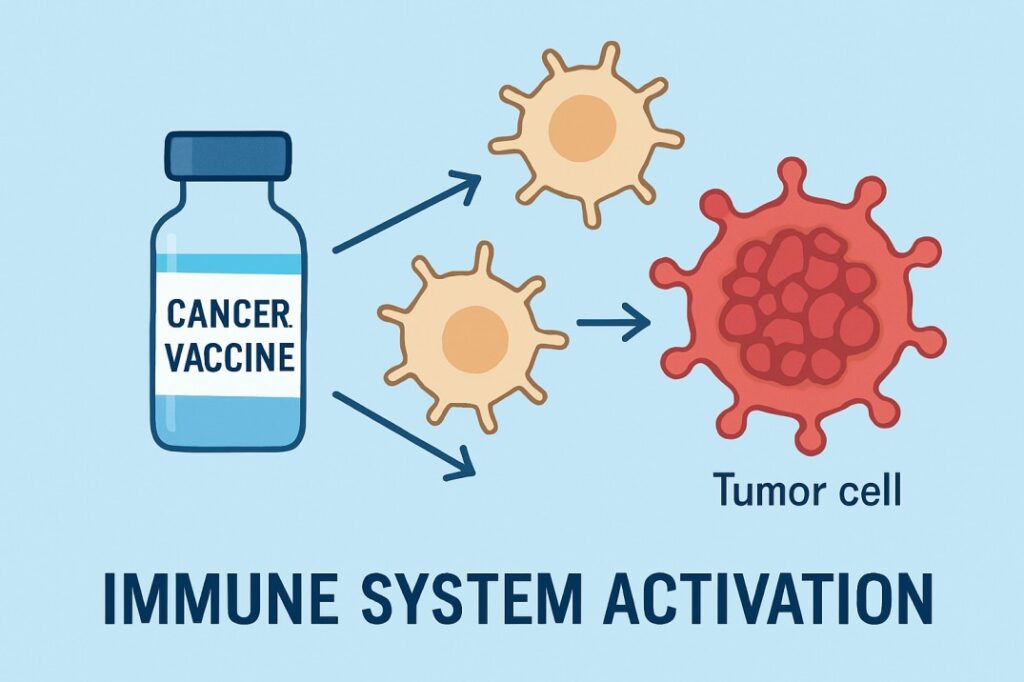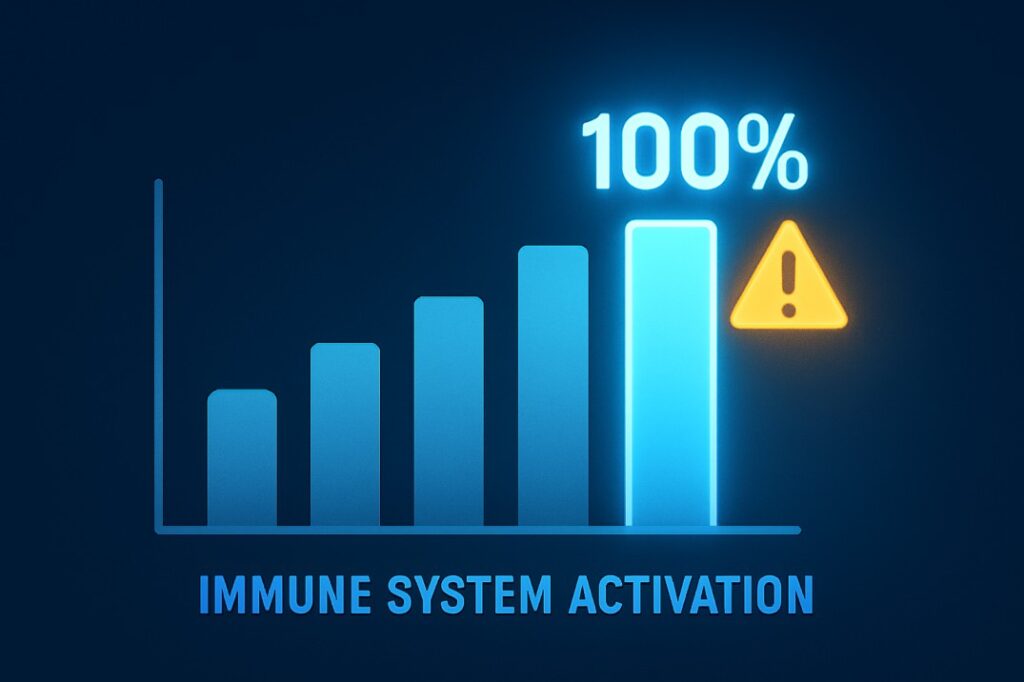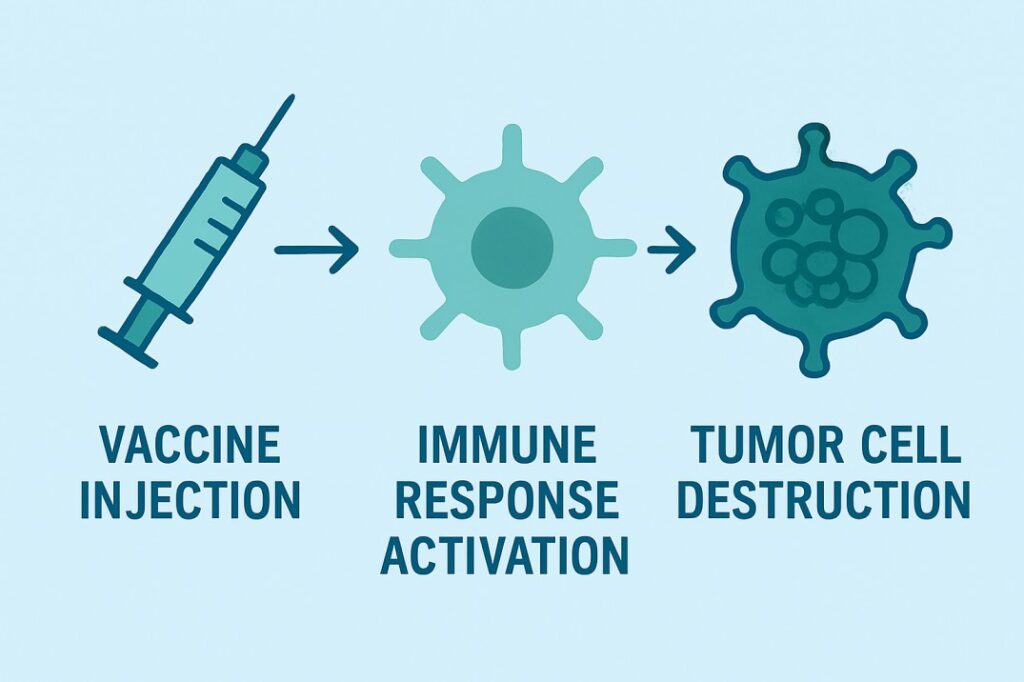
Concept illustration of Enteromix cancer vaccine with DNA helix and immune cells
Russia’s Enteromix cancer vaccine is reportedly showing 100% early efficacy. Here’s a clear, balanced explainer of what we know — and what we don’t.
Introduction — quick snapshot
Russia recently announced a major development in cancer research. The vaccine is called Enteromix. Officials say it delivered striking results in early tests. Some outlets report “100% efficacy.” Yet experts urge caution. More testing is needed before we call this a cure. TASS, Business Standard
What is the Enteromix cancer vaccine?

Enteromix cancer vaccine is described as an mRNA-based and/or oncolytic-viral approach developed by Russian research centres. The developers say the vaccine is personalised — meaning it can be adapted to a patient’s tumour profile. Early reports say it uses engineered viral vectors alongside mRNA techniques to train the immune system to attack cancer cells. TASS, ФГБУ «НМИЦ радиологии» Минздрава России
How did scientists test Enteromix?
First, researchers ran preclinical studies in labs and animal models over several years. Then, early human testing began. Russian health officials say the most recent announcements come after mandatory preclinical trials and an initial human Phase I trial. Reports mention roughly 48 volunteers in early human testing, with low toxicity observed. Still, full data are not yet publicly available in peer-reviewed journals. TASS, MedPath, Business Standard
The “100% efficacy” claim — what it likely means

When the media reports “100% efficacy,” they often summarise early or narrow results. In this case, Russian agencies and several outlets reported very strong outcomes in the early tests. However, that 100% figure appears tied to limited data or specific trial settings (for example, small groups or particular tumour models). In other words, the claim is attention-grabbing. Yet it does not yet equal proof that the vaccine will work for all patients and all cancers. Experts say larger Phase II and III trials are essential to show consistent, long-term benefit and safety. Business Standard, Ground News
What were the actual results reported?
According to official statements and press reports:
- Preclinical studies reportedly showed tumour shrinkage and slower tumour growth, with reductions between about 60% – 80% depending on disease specifics. TASS, Ensaios Clinicos
- Early human/Phase I data (small number of volunteers) reportedly showed low toxicity and promising responses. Some outlets describe “complete destruction” in certain cases, but those are isolated reports and need validation. MedPath, Business Standard
Why the scientific community is cautious
There are important reasons to be careful:
- Small sample sizes. Early trials often involve few people. Small samples can overestimate effects. MedPath
- Preclinical vs clinical. Success in animals or cell studies does not guarantee success in large human trials. TASS
- Peer review missing. Many reports so far are media summaries or official statements. Full data in peer-reviewed journals is the gold standard. Business Standard
- Different cancers behave differently. Enteromix reportedly targets colorectal cancer first, but other cancers may react differently. TASS
How Enteromix is said to work — in plain language

Put simply:
- The vaccine trains the immune system to recognise features of cancer cells.
- It combines viral tools that attack tumours directly with mRNA programming that tells immune cells what to hunt.
- The approach is personalised. That means doctors tailor the vaccine to the molecular fingerprint of an individual’s tumour.
This combination aims to shrink tumours while reducing the harsh side effects seen with chemo. However, the exact step-by-step mechanism needs full technical papers for independent review. ФГБУ «НМИЦ радиологии» Минздрава России, Business Standard
Where Enteromix fits in the global race
Several research groups worldwide are developing cancer vaccines and personalised immunotherapies. Companies like BioNTech, Moderna, and academic teams are working on mRNA or viral-vector strategies for brain, skin, and other cancers. If Enteromix proves effective in large trials, it would join a growing field of precision immunotherapy. For now, Enteromix is one promising candidate among many. Business Standard, MedPath
Timeline — what to expect next
- Russian officials say the vaccine is awaiting regulatory approval for wider use inside Russia. TASS
- The usual path forward includes Phase II trials (larger groups to test effectiveness) and Phase III trials (large, multi-centre studies comparing against standard treatments). These steps typically take months to years. MedPath
What this means for patients now
Right now, Enteromix is not a broadly approved standard treatment in most countries. People with cancer should not assume a new vaccine will be available or effective for them yet. Instead:
- Talk with your oncologist about current, proven treatment options.
- Ask whether clinical trials are available and whether you may qualify.
- Keep an eye on peer-reviewed publications and official regulator announcements for robust data. Business Standard, Ensaios Clinicos
FAQ — short and clear
Q: Is Enteromix already proven to cure cancer?
A: No. Early results are promising. But cure claims are premature. Larger clinical trials and peer-reviewed data are needed. Business Standard
Q: What does “100% efficacy” mean here?
A: It likely refers to strong responses in a limited set of early tests. It does not mean the vaccine will work for every patient or cancer type. The Times of India
Q: When will Enteromix be available to patients?
A: That depends on regulatory approvals and the outcomes of Phase II/III trials. Timelines can vary from months to years. TASS
Q: Are there safety concerns?
A: Early reports say low toxicity. Still, broad safety profiles require larger trials across diverse groups. MedPath
Q: Can I join a trial?
A: Possibly. Trials often post eligibility information publicly. Talk to your doctor or check official clinical trials registries. MedPath
Disclaimer: This article is for information only. It does not provide medical advice. Consult a qualified health professional before making medical decisions. The content summarises early reports and does not replace official guidance or peer-reviewed research. : If you found these tips helpful, share this article with friends and family. For more science-backed health insights, explore our latest blogs on Nowspress.







